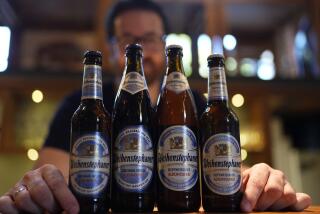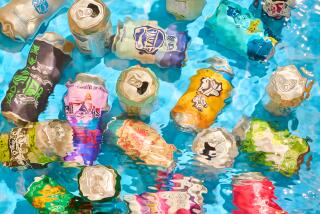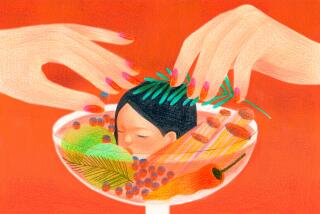Marketing of Malt Liquor Fuels Debate : Consumption: Sales of the high-alcohol beverage soar in inner cities. Critics complain that shrewd advertising in ethnic neighborhoods has turned it into a status symbol.
You wonât find Kapone savoring the taste or aroma of his beverage of choice.
The young gang member from the Imperial Courts housing project in Watts offers a simple explanation for his loyalty to malt liquor, in particular Olde English 800: âIt does the job the fastest.â
Kapone, a lanky 23-year-old who sells drugs for a living, started drinking when he was 10. To him, beer tastes like water. Even some malt liquors no longer give him a kick.
But several 40-ounce bottles of high-powered âEight Ball,â as his brand is known on the street, guarantee âa hell of a buzz,â Kapone said. âAnd it donât take all day.â
Malt liquor--which is made similarly to beer but has more than 5% alcohol--has become the drink of choice among many in the inner city. It is heavily discounted in black and Latino neighborhoods nationwide (a 40-ounce bottle can cost less than $1.50), and promotions coyly--and sometimes not so coyly--plug its potency.
âItâs a quicker high,â said David Frym, owner of Ikeâs Market on Los Angelesâ Skid Row. âYou can drink a can and feel a little lightheaded. These guys are not drinking just to quench their thirst.â
While beer consumption has been declining, sales of Colt 45, Olde English 800, King Cobra and other high-octane malt liquor brands grew 15% last year. Analysts say much of the sales gain is among ethnic minorities. Blacks, who make up 12% of the U.S. population, represent 10% of beer drinkers but 28% of malt liquor consumers, according to a study by Shanken Communications Inc. of New York City.
âIt is one of the few segments of the beer market that is growing,â said Tiziana Mohorovic, research director for Jobson Beverage Group in New York. Although it is growing quickly, she said, it accounts for only 3% of the beer market.
Brewers are moving aggressively to capitalize on the demand--but they have been forced by controversy to tread cautiously.
Coors, for one, is not in the malt liquor business. The Colorado-based brewer test-marketed a product called Magnum several years ago but decided that it did not fit into the companyâs marketing strategies, said spokeswoman Julie Demlow.
Other brewers declined to comment on malt liquor sales strategies. But a brochure sent to retailers by Pabst Brewing, which makes Olde English 800, states that the top-selling brew appeals to minorities because of its âsmooth, mellow taste brewed for relatively high alcohol content (important to the ethnic market!).â
Anti-alcohol activists angrily contend that alcoholic beverage manufacturers are taking advantage of minority groups and exacerbating inner-city problems by targeting them with high-powered blends.
âAlcohol flows in a steady stream in South-Central, and itâs alcohol thatâs in these guysâ veins when they do their mayhem,â said Don Bakeer, a teacher at Washington High School who wrote the novel on which the anti-gang film âSouth-Centralâ is based. âMalt liquor makes youngsters brave. It makes them up the ante.â
The brewersâ shrewd marketing, activists say, has turned malt liquor into an element of machismo. Macho celebrities such as Ice Cube and Billy Dee Williams are malt liquor spokesmen; billboards for the brews line the streets in poor neighborhoods.
âThe marketing campaigns say that all of the hip and cool people are now drinking malt liquor,â said Mike Neely, an activist with the Homeless Outreach Program in Los Angeles. âIt makes you sexy and appealing to women and all of the things youâre not. A whole aura has been created around this beverage.â
Colette Winlock, executive director of the National Black Alcoholism Councilâs California chapter in Oakland, said: âRight now, the big thing among young men is to hang out with a 40-ouncer. Itâs a status symbol, and the industry has created that.â
The critics are referring to commercials such as the one in which rap singer King Tee plugs St. Ides Malt Liquor, which--at 5.9% alcohol--is one of the strongest brands:
âI usually drink it when Iâm out just clowning, me and the homeboys, you know, be like downing it. Cause itâs stronger but the taste is more smooth. I grab a 40 when I want to act a fool.â
Recently, however, such bold marketing campaigns have backfired.
* G. Heileman Brewing Co. pulled PowerMaster from the market in July, 1991, after the Bureau of Alcohol, Tobacco and Firearms said its name violated federal rules barring labels or advertising that promote alcoholic potency.
The rejection by thke bureau came as critics rapped Heileman, a Wisconsin brewer that also produces Colt 45, for aiming malt liquor at minority groups. In May, after the debate had died down, the company introduced a product similar in content to PowerMaster but with a more palatable name: Colt 45 Premium.
* This year, Brooklyn-based Hornell Brewing Co. caused an uproar among American Indians when it began marketing another Heileman product, Crazy Horse Malt Liquor. U.S. Surgeon General Antonia Novello, who took up the cause, accused Hornell of being insensitive to American Indians and the alcohol problems that tear at their communities by naming the drink after a revered Sioux leader.
In September, Congress approved legislation banning the Crazy Horse brand name. The alcohol and tobacco bureau is letting merchants sell only the existing stock.
* New Yorkâs attorney general last year sued McKenzie River Corp., the San Francisco-based marketer of St. Ides, after community activists protested that the company was blatantly targeting young blacks.
In a settlement reached this year, McKenzie River agreed to pay a $50,000 settlement and refrain from touting its productâs alcohol content, marketing to underage youths or suggesting that the beverage--which is brewed by Heileman--increases virility. In addition, the Bureau of Alcohol, Tobacco and Firearms fined the company $15,000 and shut down its operations for three days.
McKenzieâs chief executive officer, Minott Wessinger, said the company has discontinued all ads for which it was criticized.
âWe made some mistakes with our advertising,â he said. âIt wasnât intentional. We certainly didnât want to offend anyone. Now weâre focusing on the future, positive messages and good community relations.â
McKenzie has begun public service announcements on AIDS, drunk driving and underage drinking--community relations efforts that are quickly becoming the new tack of malt liquor marketers.
In Chicago, Hudepohl-Schoenling Brewing Co., the nationâs eighth-largest brewer and maker of Mt. Everest malt liquor, this summer unveiled a list of commitments to that cityâs black community. The company promised to hire more African-Americans and to donate 25 cents per case to neighborhood programs.
Meanwhile, industry analysts say brewers are attempting to expand the consumer base in the $500-million malt liquor market by introducing high-end lines such as Schlitz Malt Liquor Genuine Draft, Old English 800 Draft and Colt 45 Premium.
âIt is still consumed mostly by ethnics,â Mohorovic said. âBut recently yuppies have begun drinking it too. There was a time when it was consumed only in the inner city. Now itâs being seen all over the place.â
David Grant, who heads the Institute for Black Chemical Abuse in Minneapolis, is disheartened by attempts to broaden malt liquorâs appeal. He has called on manufacturers to drop the high-alcohol products.
âThese companiesâ market research has shown them what people will buy, but they have shown a callous disregard for the consequences,â he said. âThey donât seem to know the social effect their product has.â
Malt Liquor: Cheap Brew With an Extra Jolt
Malt liquor is brewed from a base that contains a higher degree of fermentable sugars than regular beer. It also has a higher alcoholic content and is paler in color. The taste is more aromatic and slightly malty.
NATIONWIDE CONSUMPTION (In millions of 2.5-gallon cases) 1987: 76 1988: 73.6 1989: 74.7 1990: 79.7 1991: 82.9 1992: 97.8* * Estimated)
TOP-SELLING BRANDS IN 1992
Rank and Brand Name Brewer Estimated cases (In millions) 1. Olde English 800 Pabst Brewing Co. 27.6 2. Colt 45 G. Heileman Brewing Co. 24 3. Schlitz Malt Liquor Stroh Brewery Co. 20.5 4. Mickeyâs G. Heileman Brewing Co. 6.4 5. King Cobra Anheuser-Busch Inc. 6.3
ALCOHOL CONTENT OF POPULAR BRANDS (In percent)
Beers Coors: 4.5 Miller: 4.6 Budweiser: 4.7
Malt Liquors King Cobra: 6.0 Schlitz Red Bull: 6.9 St. Ides: 8.0
Source: Center for Science in the Public Interest; Jobson Publishing Corp.
More to Read
Inside the business of entertainment
The Wide Shot brings you news, analysis and insights on everything from streaming wars to production â and what it all means for the future.
You may occasionally receive promotional content from the Los Angeles Times.










